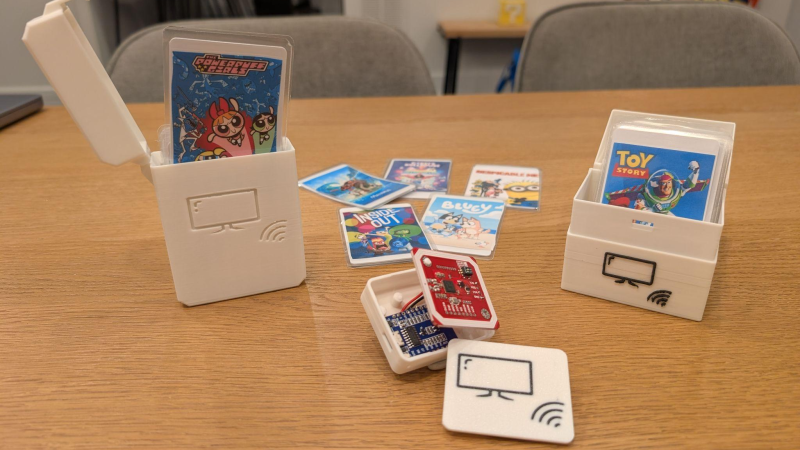For most of us, the days of having to insert a disc to play our media are increasingly behind us. But if you’d like to provide your kids with the experience, you could use CardFlix.
For the electronics, [Udi] used the readily available ESP8266 D1 Mini module connected via I2C to a PN532 NFC reader. To trigger the different movies, there are over 50 cards, each with not only its unique NFC tag but also small posters that [Udi] printed showing the show and then laminated, ensuring they will survive plenty of use. The D1 Mini and NFC reader are housed in a 3D printed case, which ends up being almost smaller than the 5V DC adapter powering it, allowing it to be mounted above an outlet out of the way. The deck of movie cards is also housed in a pair of printed boxes: the larger one for the whole collection and a small one for the most often used shows. Should you want to print your own, all the design files are provided in the write-up.
The D1 Mini was programmed using ESPHome. This firmware allows it to easily connect back to Home Assistant, which does most of the heavy lifting for this project. When a card is scanned, Home Assistant can tell which TV the scanner was near, allowing this system to be used in more than one location. It also knows which card was scanned so it can play the right movie. Home Assistant also handles ensuring the TV in question is powered on, as well as figuring out what service should be called for that particular movie to be shown.
Be sure to check out some of the other projects we’ve featured that use ESPHome to automate tasks.
















I think this is really a great idea. Of course kids should learn how to manage all these modern-day digital devices. But they’ll learn that anyway. These cards will prevent endless browsing through an endless list of possible shows, where the kid can’t make up their mind. This gives them a bunch of cards with a limited amount of choices, and I believe that will help them make a decision faster.
If you have more than one kid, they will fight over the cards, of course. Like they would fight over the endless list of possible shows on a computer. But the cards are tangible, and they won’t fight over control of the computer/tablet, but over a bunch of cards. Everyone can hold their favourite card while fighting about which show they will watch, and I imagine the fights will be a lot less physical. Kind of divide and conquer. ;)
I don’t have kids, probably that shows, hahahaha. ;) I do have a brother and sister, but when we were young we didn’t have tv-on-demand. But we did have fights over who had control over the remote, and I imagine that wasn’t very dissimilar to modern-day fights for control over the tablet. :P
I was also thinking about that it would be nice to slot the card into a small wall socket, like you do with a hotel card.
Also, to further decrease the amount of fights, add a timeout for when the system allows to change to a different program. Like 10 minutes or so. So once chosen, it’s fait-accompli for 10 minutes. Make the kids think, or reach consensus, before they choose.
Maybe I’m naive, because I know very well that kids will find something to fight about anyway. ;)
my kids are not prone to scrolling for new content. they want to watch something they’ve already watched before. they complain when i scroll for new content, even though they always love what i put on. i complain about their complaining.
Made a similar project to let my kids put on music when they were smaller (1-4 years old). Was a great way for them to pick songs, limit their options to a manageable size and keep them away from interacting with screens for a while longer :)
Sounds very similar to https://github.com/TheStockPot/NFC-Cartridge-Player which is also an NFC -> TV reader that works through home assistant.
Somehow I don’t think it is the best idea to “educate” children in to treating this sort of card, merely an address to some content, as if it were content. They might end up treasuring a particular card, as if it were of importance, whilst neglecting the device on which all the videos actually live. I fear also it gets them used to the idea of thinking that not having physical ownership of actual content, whilst mistakenly holding on to the address of some content and believing that they have “bought” it. It gets them to used to the modern buy-it-then-it-suddenly-gets-removed model of media “sales”, which they should be taught to avoid before they even first encounter it. Seriously, second hand DVDs of as many films as they’re ever likely to watch comes out much cheaper than subscriptions to all manner of services any of which may cancel something you’ve already “bought”. Better, I think, to teach them in the use of a DVD player or of how to navigate a filesystem GUI on a cheap old PC (running one of the user friendly Linux distros) with a folder filled with videos.
I helped a person named Udi with building something very similar to this, also NFC cards that play videos according to the scanned card. I started reading this and was sure this is it, but alas, this is a completely different Udi, who built a completely different project.